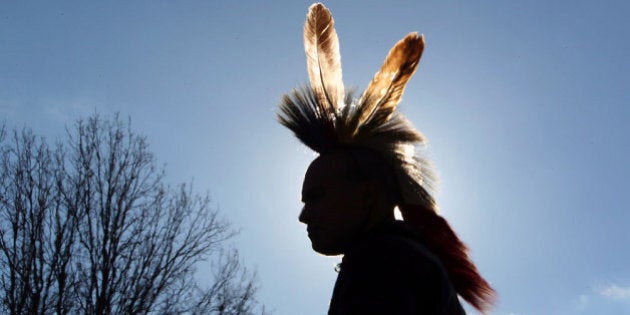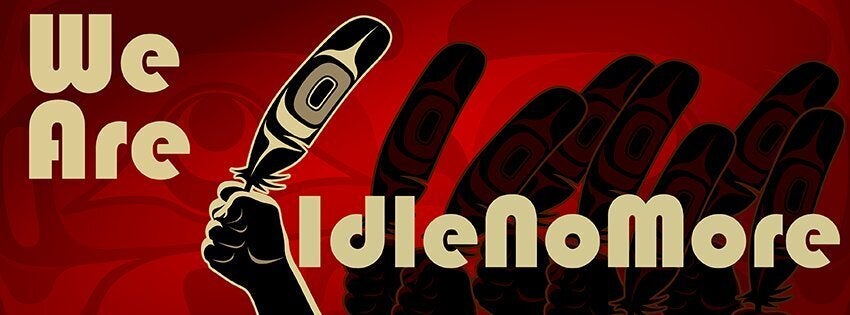
Idle No More, a movement that had so swiftly grown to command the attention of a nation, faded from view in the summer of 2013. Although prominent Aboriginal speakers talked about a "sovereignty summer" that would follow the winter of discontent, the groundswell of indigenous activism failed to materialize.
But Idle No More was not gone. Far from it. This most unusual of movements -- lacking formal structure, operating without money, and without a clear strategy -- had transformed the country and aboriginal public affairs in myriad ways.
The movement started in opposition to the Government of Canada's controversial omnibus Bill C-45, a document so large, diverse and complicated that few could speak with confidence about its contents. Idle No More was launched by four women from Saskatchewan -- Nina Wilson, Sheelah McLean, Sylvia McAdam and Jessica Gordon -- who were angered by Prime Minister Stephen Harper's strategy of burying crucial environmental legislation in a confusing budget implementation bill. Within weeks, however, it was clear that the movement was about much more than that.
Idle No More emerged from a sophisticated and comprehensive critique of Canadian aboriginal policy. The message contained in the hundreds of talks, captured on YouTube videos, distributed in tweets and Facebook postings, and articulated by founders and followers alike in many media interviews, was clear: that aboriginal people were victims of centuries of Canadian colonialism; that legacies of discrimination and marginalization persisted into the present; that indigenous peoples were tired of being ignored; and that the Canadian political, economic and environmental systems had to adjust to capture aboriginal aspirations. C-45 was the spark, but Canadian history and national policy provided the fuel that sustained the movement.
The details of Idle No More are, less than three years on, already difficult for many Canadians to recall. More would remember a side event, Attawapiskat Chief Theresa Spence's hunger strike. And more aggressive and confrontational episodes -- think of Oka, Burnt Church and Caledonia -- remain seared in the Canadian consciousness. Roadside rallies in southern Manitoba, a walk down Main Street in Whitehorse, teach-ins at college and university campuses, and dozens upon dozens of comparable activities, each one small on its own, seem ever so transient in retrospect.
Idle No More sought no singular or technical outcome. When the omnibus bill passed, the rallies continued. The purpose was not political in the capital "P" sense of that term. It was more about community building, about finding both common cause and a shared voice. The genius of the movement's founders rested in their willingness to trust aboriginal people across the country, to encourage local action, to insist on peaceful assembly, and to urge indigenous communities to celebrate their survival and demonstrate their determination.
Remarkably, Idle No More was completely without violence and confrontation. Angry words were spoken -- many about Harper -- but these were cultural gatherings in the main, focusing on drumming, singing and dancing. Young people showed up at events in the thousands, bringing their children with them to join in the largest affirmation and demonstration of indigenous cultural survival, determination and persistence in Canadian history.
This, ultimately, is why Idle No More lives on. It was a game-changer in Canadian public life. Its founders urged indigenous people to find and exercise their voice. And they did. There was anger at the Government of Canada, to be sure, but also frustration at local indigenous leaders. The core message was that aboriginal people had to speak up and let the country know what they thought on all issues, from environmental sustainability and resource development, education and systemic racism, poverty, and violence toward indigenous women.
Idle No More lives on in the form of empowered and determined aboriginal activists. There were many committed and capable indigenous leaders in the past, but the movement added greatly to their ranks. There is a new and continuing level of commitment across the country that shows up in reaction to proposals such as the Northern Gateway Pipeline, and demands for an inquiry into missing and murdered aboriginal women. It shows up, equally, in aboriginal confidence inside organizations and institutions, like universities and colleges, within local aboriginal governments, and in relations with government officials and corporations.
Idle No More was not a failure and has not disappeared. The country as a whole, particularly at the political and governmental levels, understands both the determination and frustrations of aboriginal people in new ways, is wary and even nervous about the power to mobilize of indigenous communities, and is more alert to the realization that indigenous Canadians actually have this country's historical and contemporary shortcomings pegged. Aboriginal people will be silent no more. And that, truly for the betterment of this country, is sure to be the most lasting legacy of the Idle No More Movement.
ALSO ON HUFFPOST:
